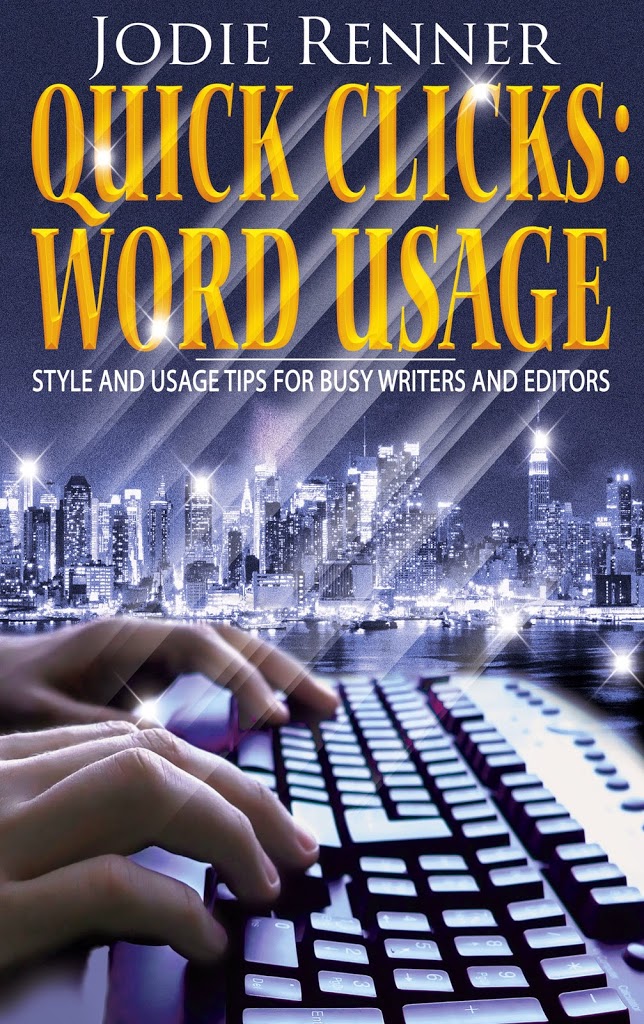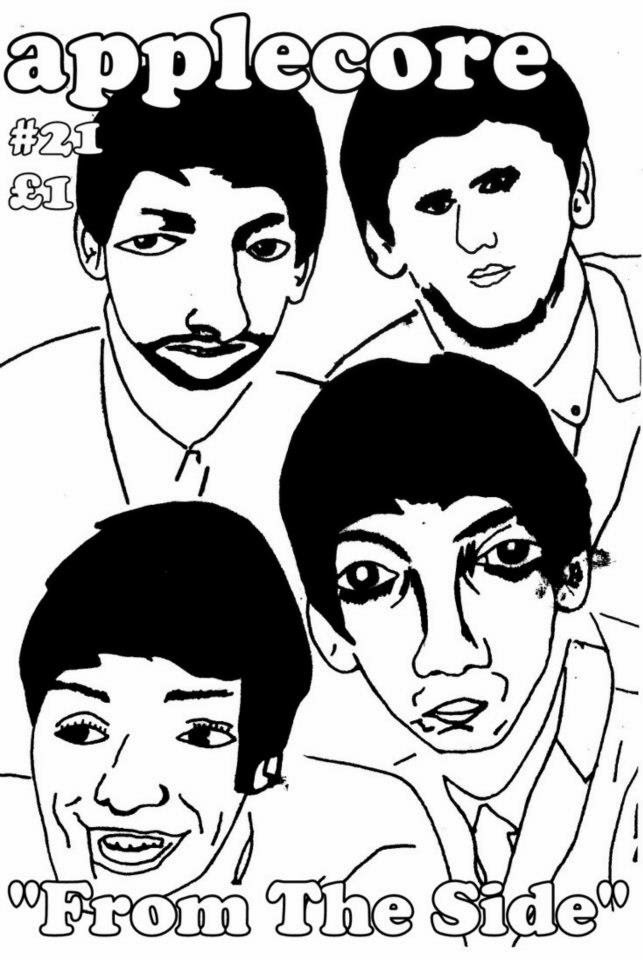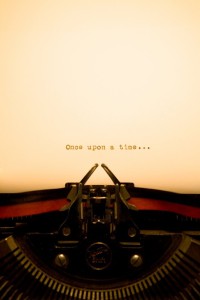Happy Halloween! Tell us about any ghosts, hauntings, or paranormal events you have encountered in “real” life. The creepier the tale, the better!
Monthly Archives: October 2014
Basic Formatting of Your Manuscript (Formatting 101)
 by Jodie Renner, editor & author @JodieRennerEd
by Jodie Renner, editor & author @JodieRennerEd
Often, the first thing I have to do when I receive a manuscript for potential editing, before starting my sample edit, is to reformat it, so it’s easier for me to read. Here are some guidelines for formatting your manuscript before submitting it to a freelance editor, a formatter, a contest, an agent, or a publisher. Most of these instructions are for Microsoft Word, 2007 or later.
1. For editing, your manuscript needs to be in Microsoft Word (Microsoft Office). This is a must, as almost all editors use Word’s Track Changes.
2. Send the manuscript as a .doc or .docx, unless instructed otherwise. Some contests prefer or require rich text format (.rtf) or even plain text (.txt), but most submissions want .doc or .docx documents.
3. The preferred font is Times New Roman or something similar. It’s easier to read than many other fonts. The font size should be 12-point.
4. To change the font and size for the whole manuscript instantly, click Control + A (for All) at the same time, which highlights the entire manuscript, then change the font and size by using the toolbar on “Home,” and then click “Enter.”
5. Left-justify the text, rather than justifying both sides. That way, it’s easier for the editor to spot spacing errors. That means the text is lined up straight down the left side (except for indents), but the right side is jagged, depending on the length of the last word in the line. To do that, click Control + A, then click the left-justify icon on the toolbar along the top (Click tab for Home first). You can also do that by clicking on the little arrow to the bottom and right of “Paragraph,” then click on the down arrow beside “Alignment” and click on “Left.”
6. Use only one space between sentences, not two. Two spaces between the period and capital went out with manual typewriters.
 7. Do not press “Enter” at the ends of the lines to add an extra line-space between the lines! This is a HUGE no-no! It causes major headaches and a lot of frustration. As soon as a few words are added or deleted (which is what editing’s all about), everything screws up. So make sure that when you’re typing and you come to the end of a line, do not press “Enter” unless it’s for a new paragraph. Let the text “wrap” around on its own.
7. Do not press “Enter” at the ends of the lines to add an extra line-space between the lines! This is a HUGE no-no! It causes major headaches and a lot of frustration. As soon as a few words are added or deleted (which is what editing’s all about), everything screws up. So make sure that when you’re typing and you come to the end of a line, do not press “Enter” unless it’s for a new paragraph. Let the text “wrap” around on its own.
8. A quick and easy way to double-space your whole manuscript: Control + A (for “all”), then Control + 2 (Click on Ctrl and on 2 at the same time). Voilà! It’s done! To change the whole manuscript back to single spacing later, click on Ctrl + A, then Ctrl + 1.
9. To see at a glance all kinds of formatting errors, click on the paragraph symbol on the toolbar along the top. It’s called a “Pilcrow” and it looks like a backward “P”. Here it is: ¶. You’ll see dots where spaces are and a ¶ for every hard return (Enter), at the end of a paragraph or for an empty line space between paragraphs.
10. Correct spacing between sentences. Click on that ¶ symbol again to see a dot for every space (click of the space bar). If you have two (or 3 or 4) dots instead of one between sentences (between the period and the next capital), you need to take out the extra spaces and just have one space between sentences. You can fix that for the whole manuscript in a second or two by using Find and Replace. Click on “Replace,” then after “Find what” hit the space bar twice (if you have 2 spaces). Then after “Replace with” click the space bar once. Then click on “Replace all” and Voilà again! All fixed! (Unless of course you sometimes have 3 or even 4 spaces between random sentences, as I occasionally see in my editing – a heavy or over-enthusiastic thumb, I guess.)
11. Correct line-spacing and paragraphing: Click on that ¶ symbol in the toolbar again. You’ll see the pilcrow symbol ¶ at the end of every paragraph, to indicate a hard return (“Enter”), and then again at the beginning of a line-space. If you see the ¶ at the end of every line, all down the right margin, that’s a real problem – the biggest formatting mistake of all! You need to remove those pilcrows (returns) at the end of every line, either by using your “Delete” or “Backspace” keys before or after them, or by doing a “Find and Replace.” After “Find” you type in this: ^p (for the pilcrow or paragraph mark). After “Replace” you just hit the space bar once, to replace the carriage return with a space.
When you click on that pilcrow sign ¶, also look for extra dots at the beginnings of paragraphs, before the first indented word, and take them all out. There should just be the indents, with no extra dots in front of them. (I see that quite a lot in manuscripts I edit.)
Note that you should only see the pilcrow ¶ in two places – at the end of a paragraph, and on any blank line. If you see a ¶ anywhere other than those two locations, it’s misplaced and will probably cause some type of inadvertent mischief.
12. Paragraphing for fiction: For fiction manuscripts, don’t add an extra line-space between paragraphs. Just leave it at your normal double-spacing. Press “Enter” at the end of the last paragraph, then indent the new paragraph (0.3 to 0.5 inch) using the built-in paragraph styles, rather than tabs or spaces. (See #15 below for instructions on how to indent the right way.)
13. Paragraphing for nonfiction: Nonfiction usually uses block formatting, with no indents for new paragraphs but instead an extra space between paragraphs.
14. General rule for indenting and spacing paragraphs: If you indent your paragraphs, don’t leave an extra space between paragraphs; if you don’t indent, insert the extra space between paragraphs.
15. How to indent the first line of each paragraph:
Do not click repeatedly on the space bar to indent! Click on that pilcrow again ¶ and if you see 2-6 dots at the beginning of the paragraph, you’ve used the space bar to indent. That’s another big no-no, and a bit of a headache to fix, especially if you don’t always use the exact same number of spaces. Using the “Tab” key to indent paragraphs is also not the best. By far the best way to indent for the first line of a new paragraph is to use Word’s formatting. To do this for the whole manuscript at once, use Control + A (for All), then, in the toolbar along the top, click on the little arrow to the bottom right of “Paragraph” (in Word 2010), then under “Special” click on “First line,” then 0.5″ or 0.4″ or 0.3″. Don’t go for less than .3″ or more than .5″.
And by the way, by popular current convention, the first line of a new chapter or scene is not usually indented – don’t ask me why!
16. To center your title and chapter headings, do not repeatedly click on the space bar. Again, if you click on the pilcrow (¶) and you can see a bunch of dots in front of the title, you’ve used the space bar to get it over there in the middle. And don’t use the Tab key for that, either. Instead, highlight the title with your cursor, then click on the centering in the toolbar along the top, under the “Home” tab. Or go to “Paragraph” below that, and click on the arrow in the lower right corner, then go to “Alignment,” then click the down arrow and choose “Centering.” A quick trick for centering a word or phrase is to click your cursor in the middle of it, then click Ctrl + E. (Thanks to Hitch for this one!)
17. For extra line spaces between chapters, do not repeatedly click on Enter or Return. To force a page break at the end of a chapter (in Word 2010), place your cursor at the end of the chapter, usually on the line below the last sentence, then, in the toolbar along the top, click on the tab “Insert” then click on “Page Break.” In Word 2007, click on “Page Layout” in the toolbar, then click on “Breaks”, then on “Page.” Another quick trick? Press CTRL+Enter. This will give you a forced page break for the end of each chapter. Do not do this at the end of a normal page, only for the end of a chapter. (Thanks, Hitch, for another trick!)
18. Your next chapter heading (chapter name or number) should start at least 3 line-spaces down from the top of the page.
19. For more advanced, specific formatting, read the guidelines set out by the agent or publisher. Or stay tuned for “Formatting 102,” to appear here at some future time. And of course, formatting for publication, for example on Kindle, involves a lot more that’s not discussed here! Especially if you’re writing nonfiction like I do, with subheadings and lists.
20. And a few quick notes about formatting for dialogue:
~ Make a new paragraph for each new person talking. Also a new paragraph for someone else reacting to the previous speaker.
~ Comma after “said”: He said, “How are you?”
~ Comma at the end of the spoken sentence, where a period would normally go, inside the last quotation mark: “Come with me,” she said.
 Jodie Renner is a freelance fiction editor and the award-winning author of three craft-of-writing guides in her series An Editor’s Guide to Writing Compelling Fiction: Captivate Your Readers, Fire up Your Fiction, and Writing a Killer Thriller. She has also published two clickable time-saving e-resources to date: Quick Clicks: Spelling List and Quick Clicks: Word Usage. You can find Jodie at www.JodieRenner.com, www.JodieRennerEditing.com, her blog, http://jodierennerediting.blogspot.com/, and on Facebook, Twitter, and Google+.
Jodie Renner is a freelance fiction editor and the award-winning author of three craft-of-writing guides in her series An Editor’s Guide to Writing Compelling Fiction: Captivate Your Readers, Fire up Your Fiction, and Writing a Killer Thriller. She has also published two clickable time-saving e-resources to date: Quick Clicks: Spelling List and Quick Clicks: Word Usage. You can find Jodie at www.JodieRenner.com, www.JodieRennerEditing.com, her blog, http://jodierennerediting.blogspot.com/, and on Facebook, Twitter, and Google+.
Coming To Terms
When I first started trying to write fiction, about the only thing I knew for sure was that I wanted to tell a story. I had no  idea what the basic rules for writing were, so I broke them all. I also came across many words and terms related to writing that remained undefined for a long time. As time passed, I started honing the craft and the terminology that goes with it. I’m still learning the craft today, but once a term is defined, it rarely changes. To help those that are just getting their feet wet in this wacky business of making stuff up in a dark room staring at a monitor and talking to imaginary people, here are a few terms that I wish someone would have defined for me back in the day. Hope there’s one here that you’ve wondered about but never knew for sure. Or maybe two or three. So let’s come to terms with writing terms.
idea what the basic rules for writing were, so I broke them all. I also came across many words and terms related to writing that remained undefined for a long time. As time passed, I started honing the craft and the terminology that goes with it. I’m still learning the craft today, but once a term is defined, it rarely changes. To help those that are just getting their feet wet in this wacky business of making stuff up in a dark room staring at a monitor and talking to imaginary people, here are a few terms that I wish someone would have defined for me back in the day. Hope there’s one here that you’ve wondered about but never knew for sure. Or maybe two or three. So let’s come to terms with writing terms.
Concept: A vague notion such as: A world ruled by apes.
High Concept: Usually verges on the outrageous or bigger-than-life “world” story such as: A world ruled by apes where humans are the subspecies.
Idea: A story description that sounds more like a short synopsis.
Premise: Similar to an idea, the premise is a one- or two-sentence reply to the question: “What is your story about?”
Genre: Categories of fiction (suspense, science fiction, horror, romance, etc.) that help create inherent expectations for the reader. Each genre will predetermine your basic story structure.
Mystery: Usually begins with an event and spends the rest of the story finding who caused it.
Thriller: Usually begins with the threat of an event and spends the rest of the story trying to stop it.
Plot: A series of events that determine the beginning, middle and end of a story.
Subplot(s): A secondary series of events that contribute to the main plot and characters.
Commercial Fiction: Plots that generally deal with externally driven characters and conflicts.
Literary Fiction: Plots that generally deal with internally driven characters and conflicts.
Plot Driven: A story that relies heavily on a series of events to push the characters forward.
Character Driven: A story that relies heavily on the characters to push the plot forward.
Story Question: A global question posed early in the story that intrigues the reader enough to keep reading. The story question signals to the reader when the story will end.
Theme: What the story says about the human condition.
Moral: A life lesson taught or insinuated at the conclusion of a story.
Suspense: Creates a desire in the reader for something to happen, delays the satisfaction of that desire, then delivers what the reader wants in an anticipated yet unexpected manner. Suspense is used to keep the reader wanting to read more.
Conflict: Conflict is the basic difference of goals between the protagonist and antagonist.
Foreshadow: The delivery of small hints about what’s going to happen later in the novel, and is used to heighten suspense.
Telegraphing: Revealing too much too soon. Telegraphing can diminish or destroy suspense.
Query Letter: A one- or two-page business letter to an agent or editor that serves as an introduction and selling tool for the writer and story.
Elevator Pitch: Similar to the premise, the elevator pitch is a short summary of the story that is meant to attract the attention of an agent or editor.
Copy Editor: An editor who addresses such story elements as word choice, plot points, paragraph flow, clichés and style issues. The copy editor will also point out a need for clarification and possible plot mistakes.
Line Editor: An editor who deals with the rules of grammar and punctuation along with addressing such issues as passive voice and formatting.
Acquisition Editor: an editor who reviews submitted manuscripts for possible purchase and publications. The acquisition editor also deals with global issues that might need addressing before the manuscript is accepted.
This is by no means a complete list of writing terminology. Additional lists can be compiled dealing with terms about publishing contracts, marketing, and so many other topics. So, Kill-Zoners, is there a term and definition you would like to contribute to today’s discussion? Perhaps a term you would like defined. Now’s your chance to come to terms.
FB and Twitter, she just can’t quit you
Eighteen months ago, I wrote a post in which I wondered whether social media were developing a personality disorder. Now I’m wondering whether social media are causing people to develop personality disorders.
Over the years, the content of my Facebook feed has become progressively darker. It’s reliably clogged with distressing missives–political rants, plus tales of woe about suffering animals and the environment. (I suspect this content appears because Facebook’s algorithm, like Google’s, does an excellent job of micro tracking everything I “Like”, share, or search for.) Yes, I care about these issues, but I don’t want to be slapped in the face with how dreadful everything is, first thing in the morning when I turn on the computer.
The more I read these distressing posts, the more upset I get about the state of the world. I do try to tune much of it out. For example, I skip over my friends’ political rants online–they’re tiresome, no matter what the point of view. (I don’t block these friends, because some of these people are dear to me in real life.) But I worry about my friends who are struggling with depression or some other personal issue in real life, who do nothing but mutter darkly online about the nefarious activities of Evil Government, or Evil Corporations. Is it a sign that they’re slipping over the edge?
I tell you, it’s enough to make me long for the boring old days when people shared what they ate for breakfast.
And it’s not just Facebook. Whenever there’s a breaking news, I find that I stay ahead of the headlines on cable news by monitoring Twitter updates. Twitter has become our new wire service, and anyone can use it. I’ve developed an unhealthy fixation with the #Breaking hashtag.
I know there’s a simple solution to my situation. “Turn it off! Unplug!” Easier said than done. I’ve been a news junkie all my life. Now apparently I’m a social media junkie, as well.
We’ve become a nation of social media junkies, it seems. I remember an incident from years ago. I was at a cocktail party, and feeling uncomfortable for some reason. I withdrew to a dark corner and began checking my cell phone. My husband came over to see what was wrong. Nowadays, I don’t think he’d bother. Everywhere one goes, everyone is checking their devices.
In the context of this discussion, I have to mention the Marysville shooting. I was stunned to see excerpts of the conversations that some of children involved had been posting online. I’m wondering why minors are even allowed to post profanity, plus violent and sexual content. Unfortunately, that kind of language seems to be the rule among adolescents in the Twitter-verse, rather than the exception. And that’s scary.
When one of my daughters was young, she was an early adopter of computer technology. She had taught herself to create a web site, and she posted a .gif of an animated dancing devil, complete with pitchfork. The image caused a big kerfuffle among the mothers of her friends, I recall, and I made her shut the site down. (I actually thought the dancing devil was kind of cute and creative, which tells you something about me. But I did want her to learn to respect “community standards”, such as they were back then).
Fast forward to current time. Where are the mothers and fathers who should be monitoring their kids’ online activities today? Perhaps we’ve all become used to a level of discourse that’s unhealthy. Perhaps it’s unhealthy for us, as well as for our children.
Here I was complaining about Facebook rants, but I seem to have written one of my own today. As writers, I know we all tend to be heavy users of social media. (For example, the #amwriting hashtag is a frequent trend on Twitter.) Do you think that social media is causing people to develop personality disorders, or does it merely reflect a pre-existing condition?
Choosing Character Names
I’m winging my way to Australia today so apologies that I won’t be able to join in the discussion. I will, however, be trying to do a little writing on the way (although you all know how hard I find it to write ‘in public’!). I started a new project last week and have been enjoying coming up with my new characters’ names – something I always have a lot of fun with and yet also suffer way too much angst over…
A character’s name can be critical to establishing the voice and feel of that person in the world that I am creating, and I often spend a considerable amount of time tinkering with main character names until they feel and fit the character exactly right.
Since I mainly write historical novels, I have a number of resources at my disposal to help me come up with names. These include lists of popular boys and girls names for the time period I’m writing about as well as handy British last name resources like census data, historical records, newspapers, magazines and even Debrett’s (I often write about aristocrats, after all!). I’m like a sponge at first, soaking in all the details about names and then I play around with combinations until I find the right fit. Since I’ve also been writing with a renewed sense of appreciation for the humor in certain names, I have also been rereading Charles Dickens. He is, in my opinion, one of the cleverest ‘namers’ in literature (who can forget names like Uriah Heep, Ebenezer Scrooge or Mr. Pumblechook!). I recently discovered the often hilarious Dickens name generator and have spent many an hour or two concocting my own ‘Dickensian’ type names.
So how do you come up with your character names? What resources do you use and how much time and effort do you spend? Is it something you agonize over, trying to make sure the name ‘fits’ the character or do you find the names just come to you and slide on your characters as easily as a silk glove? Apart from Dickens, who do you think has come up with some of the greatest, most memorable character names?
Sympathy for the Devil: Writing Unforgettable Villains
James Scott Bell
@jamesscottbell
Note: This does not mean you are giving approval to what the villain has done. No way. What you are getting at is his motivation. This is how to know what’s going on inside your villain’s head throughout the entire novel.
In Praise of Henry Pritchard
Reader Friday: Early Signs of Being a Writer
The TKZ Monthly Critique Group: The Shattered Kingdom
Attending a Writers Conference
Today I am on my way to the Novelists, Inc. conference at St. Pete Beach. As I am contemplating what to say here, I’m thinking about the benefits of spending a wad of money to attend a writers conference. Ninc focuses solely on the business of writing for career professionals. You must have two published novels to join, so the membership consists of multi-published authors. This makes it different from any other conference, which may be aimed toward fans or writers at all levels.
Ninc doesn’t aim to teach you to write. It aims to get you up to date on industry news and trends in publishing; the how-to’s regarding promotion & marketing, indie publishing; legal aspects like literary estate planning and forming a collaborative group to produce a book box package; how to use Amazon or Book Bub or Goodreads effectively. Reps from Kobo, Amazon, iBooks and more will be present. I can’t wait to attend. I can pick anyone’s brain there for any career questions I might have, and I have plenty. Ninc is a goldmine of seasoned, professional authors.
So why should you attend a writers, as opposed to a fan, conference? Here are some of the benefits:
· Networking with other authors and making new friends
· Career guidance from more experienced authors
· Attracting new readers, as authors are readers, too.
· Workshops at all skill levels
· Editor/Agent appointments
· Name recognition
· Meeting authors whom you might ask later for an endorsement
· Giving back to the writing community by offering a workshop or volunteering
I have been attending SleuthFest for years. This premier mystery writers conference will take place Feb. 26 at Deerfield Beach, FL. And new this year is the Flamingo Pitch Tank, where you get the chance to pitch your novel to every attending editor and agent at once. This is in addition to one-on-one appointments. You’ll learn about marketing and brush up on your other writing skills. Last year I attended workshops on Kobo and ACX. So check out this event before it sells out. James Patterson and Dave Barry are guest speakers.
What other reasons can you offer for attending a writers conference? As I will be unable to respond, please talk amongst yourselves. I’ll respond next week when I am back home.







